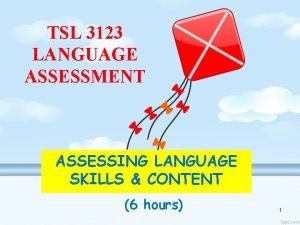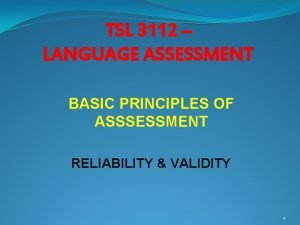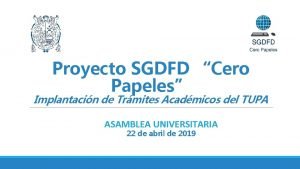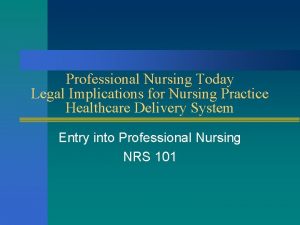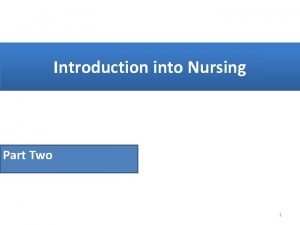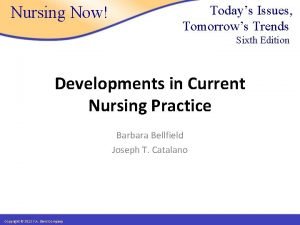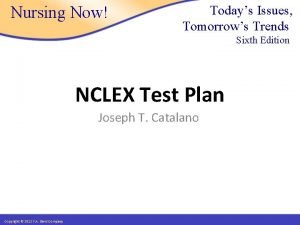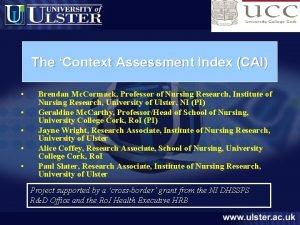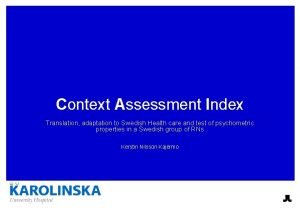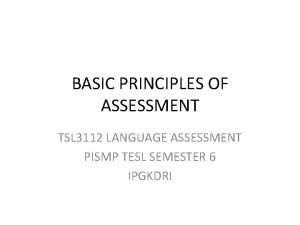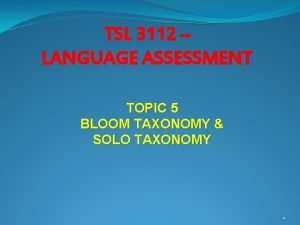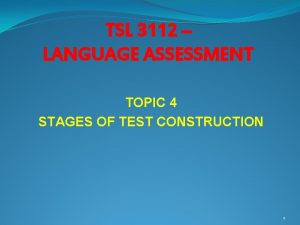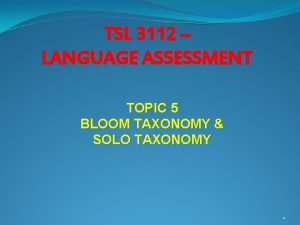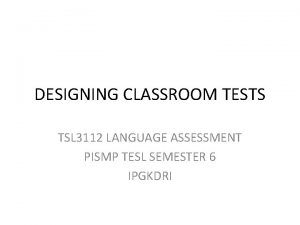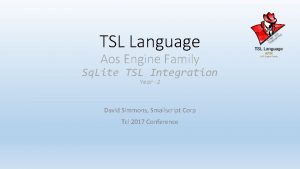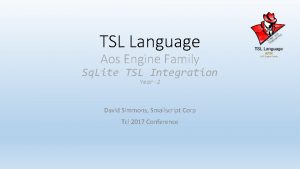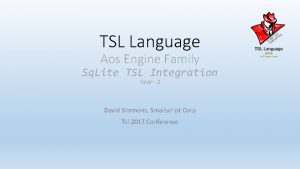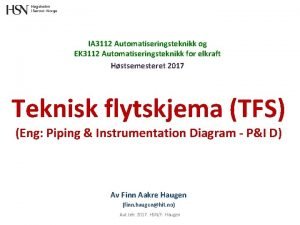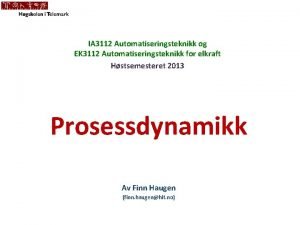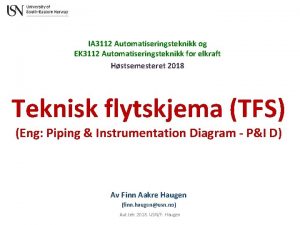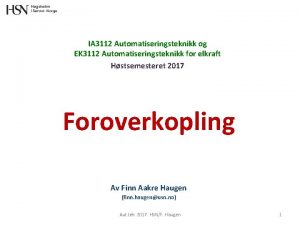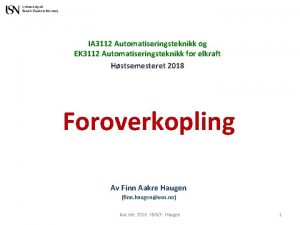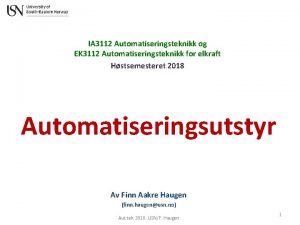OVERVIEW OF ASSESSMENT CONTEXT ISSUES TRENDS TSL 3112























- Slides: 23

OVERVIEW OF ASSESSMENT: CONTEXT, ISSUES & TRENDS TSL 3112 LANGUAGE ASSESSMENT PISMP TESL SEMESTER 6 IPGKDRI

DEFINITION OF TERMS • Assessment: – “appraising or estimating the level or magnitude of some attribute of a person” (Mousavi, 2009). – An ongoing process that encompasses a wide range of methodological techniques – e. g. students’ responses, comments or trying out new words / structures. – A good teacher never ceases to assess students – incidental or intended.

DEFINITION OF TERMS • Test: – A method of measuring a person’s ability, knowledge, or performance in a given domain. – A subset of assessment, a genre of assessment techniques. – A prepared administrative procedure which occurs at identifiable times in a curriculum when learners muster all their faculties to offer peak performance, knowing that their responses are being measured and evaluated.

DEFINITION OF TERMS • Test: – A method: an instrument – a set of techniques, procedures, or items – that requires performance on the par of the test-taker. – Measure: a process of quantifying a test-taker’s performance according to explicit procedures or rules (Bachman, 1990). – The measurement of individual’s ability, knowledge, or performance / competence.

DEFINITION OF TERMS • Test: – The measurement of a given domain. – Thus, a well-constructed test is an instrument that provides an accurate measure of the test-taker’s ability within a particular domain.

DEFINITION OF TERMS • Measurement: – The process of quantifying the observed performance of classroom learners. – The issue of QUANTITATIVE & QUALITATIVE descriptions of student performance. – Quantitative – assigning numbers, i. e. rankings and letter grades. – Qualitative – written descriptions, oral feedback, and other nonquantifiable reports.

DEFINITION OF TERMS • Evaluation: – The interpretation of information. – Does not necessarily entail testing; rather, evaluation is involved when the results of a test (or other assessment procedure) are used for decision making (Bachman, 1990). – I. O. W. – you evaluate when you value the results.

DEFINITION OF TERMS Tests Measurement Assessment Teaching Evaluation

HISTORICAL DEVELOPMENT IN LANGUAGE ASSESSMENT • Language-testing trends and practices have followed the shifting sands of teaching methodology. • For examples: – 1940 s & 1950 s – an era of behaviourism and special attention to contrastive analysis, language tests focused on specific linguistic elements. – 1970 s & 1980 s – communicative theories of language brought with them a more integrative view of testing.

HISTORICAL DEVELOPMENT IN LANGUAGE ASSESSMENT • Behavioural Influences on Language Testing: – Through the middle of the 20 th century, language teaching and testing – strongly influenced by behavioural psychology and structural linguistics. – Emphasis on sentence-level grammatical paradigms, definitions of vocabulary items, and translation. – Test consisted of grammar and vocabulary items in MCQ with a variety of translation exercises – words, sentences, and short paragraphs.

HISTORICAL DEVELOPMENT IN LANGUAGE ASSESSMENT • Behavioural Influences on Language Testing: – Discrete-point formats – the assumption that language can be broken down into its component parts. – The psychometric-structuralist approach – test designers seized the tools of the day to focus on issues of validity, reliability, and objectivity.

HISTORICAL DEVELOPMENT IN LANGUAGE ASSESSMENT • Integrative Approaches: – In the midst of this fervor, language pedagogy was rapidly moving in more communicative directions. – The profession emerged into an era emphasizing communication, authenticity, and context – new approaches were sought. – John Oller (1979) argued that language competence was a unified set of interacting abilities that could not be tested separately.

HISTORICAL DEVELOPMENT IN LANGUAGE ASSESSMENT • Integrative Approaches: – The introduction of integrative testing. – Two types: cloze tests and dictations. – Proponents of integrative test methods centred their arguments on what became known as the unitary trait hypothesis – an invisible view of language proficiency: that vocabulary, grammar, phonology, and the four language skills and other discrete points of language could not be disentangled from each other in language performance. – However, it was eventually abandoned.

HISTORICAL DEVELOPMENT IN LANGUAGE ASSESSMENT • Communicative Language Testing: – The mid-1980 s – Canale and Swain’s (1980) seminal work on communicative competence resulted the language-testing field had begun to focus on designing communicative languagetesting tasks. – Bachman and Palmer (1996) included among fundamental principles of language testing the need for a correspondence between language test performance and language use.

HISTORICAL DEVELOPMENT IN LANGUAGE ASSESSMENT • Communicative Language Testing: – The problem faced – tasks tended to be artificial, contrived, and unlikely to mirror language use in real life. – The quest for authenticity – centred on communicative performance. – Following Canale and Swain’s (1980) model – Bachman (1990) proposed a model of language competence:

Language Competence Organisational Competence Grammatical Competence - Vocabulary - Morphology -Syntax - Phonology / Graphology Textual Competence - Cohesion - Rhetorical Organisation Pragmatic Competence Illocutionary Competence - Ideational Functions - Manipulative Functions - Heuristic Functions - Imaginative Functions Sociolinguistic Competence - Sensitivity to Dialect / Variety - Sensitivity to Register - Sensitivity to Naturalness - Cultural References and Figures of Speech

HISTORICAL DEVELOPMENT IN LANGUAGE ASSESSMENT • Communicative Language Testing: – Bachman and Palmer (1996) also emphasised on the importance of strategic competence, i. e. the ability to employ communicative strategies to compensate for breakdowns & enhance rhetorical effect of utterances, in the process of communication. – Challenges: to identify the kinds of real-world tasks that language learners to perform, the contexts were too widely varied, & the sampling of tasks for assessment procedure needed to be validated.

HISTORICAL DEVELOPMENT IN LANGUAGE ASSESSMENT • Communicative Language Testing: – Weir (1990) – to measure language proficiency: where, when, how, with whom, and why language is to be used, and on what topics, and with what effect. – The assessment field became more concerned with the authenticity of tasks and the genuineness of texts.

HISTORICAL DEVELOPMENT IN LANGUAGE ASSESSMENT • Performance-Based Assessment: – The new and more student-centred agenda. – Involve oral production, written production, openended responses, integrated performance (across skill areas), group performance, and other interactive tasks. – Time-consuming & relatively expensive; however, result in more direct and more accurate testing – students are assessed as they perform actual and stimulated real-world tasks.

HISTORICAL DEVELOPMENT IN LANGUAGE ASSESSMENT • Performance-Based Assessment: – Higher content validity – learners are measured in the process of performing the targeted linguistic acts. – In an English language teaching context – teachers may face a difficult time to distinguish between formal and informal assessment. – The goals of performance-based assessment will be met if relying a little less on formally structured tests and a little more on evaluation.

HISTORICAL DEVELOPMENT IN LANGUAGE ASSESSMENT • Performance-Based Assessment: – A characteristic of many performance-based language assessments is the presence of interactive tasks (a. k. a. task-based assessment). – The assessments involve learners in actually performing the behaviour to measure. – Test-takers are measured in the act of speaking, requesting, responding, or in combining listening and speaking, and in integrating reading and writing.

HISTORICAL DEVELOPMENT IN LANGUAGE ASSESSMENT • Performance-Based Assessment: – A prime example – oral interview: the authenticity of real-life language use.

CHANGING TRENDS IN LANGUAGE ASSESSMENT – MALAYSIAN CONTEXT • Tutorial questions: – Compare and contrast informal and formal assessments. – Compare and contrast the implementation of assessments between the KBSR and KSSR.
 Tsl success trading sdn bhd
Tsl success trading sdn bhd Tsl success trading sdn bhd
Tsl success trading sdn bhd Tsl logistics
Tsl logistics Implantacion
Implantacion What is tsl in trading
What is tsl in trading Trends and issues in nursing
Trends and issues in nursing Trends and issues in nursing
Trends and issues in nursing Nursing now today's issues tomorrow's trends
Nursing now today's issues tomorrow's trends Nursing now today's issues tomorrow's trends
Nursing now today's issues tomorrow's trends Moral dimensions of information systems
Moral dimensions of information systems Nonagist
Nonagist Communicating across generational differences
Communicating across generational differences Presupposition triggers
Presupposition triggers Contoh komunikasi high context dan low context
Contoh komunikasi high context dan low context Context assessment index
Context assessment index Context assessment index
Context assessment index Documentation portfolio example
Documentation portfolio example Static assessment vs dynamic assessment
Static assessment vs dynamic assessment Portfolio assessment matches assessment to teaching
Portfolio assessment matches assessment to teaching Www overview
Www overview Maximo overview
Maximo overview Universal modeling language
Universal modeling language In uml is a connection among things
In uml is a connection among things Vertical overview
Vertical overview
